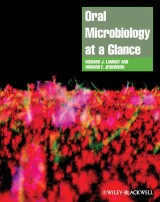Details

Oral Microbiology at a Glance
At a Glance (Dentistry), Band 38 1. Aufl.
|
45,99 € |
|
| Verlag: | Wiley-Blackwell |
| Format: | |
| Veröffentl.: | 22.02.2010 |
| ISBN/EAN: | 9781444315387 |
| Sprache: | englisch |
| Anzahl Seiten: | 96 |
DRM-geschütztes eBook, Sie benötigen z.B. Adobe Digital Editions und eine Adobe ID zum Lesen.
Beschreibungen
<i>Oral Microbiology At A Glance</i> is a title in the highly popular <i>at a Glance</i> series. It provides a concise and accessible introduction and revision aid. Following the familiar, easy-to-use <i>at a Glance</i> format, each topic is presented as a double-page spread with key facts accompanied by clear diagrams encapsulating essential information. <p>Systematically organized and succinctly delivered, <i>Oral Microbiology At A Glance</i> covers:</p> <ul type="disc"> <li>Oral microbial origins of health or disease </li> <li>Various infections ranging from dental caries, periodontal and endodontic infections to oral mucosal, bone, and systemic infections </li> <li>Local and systemic extensions of oral infections </li> <li>Sterilization, disinfection, infection control methods, and bioterrorism </li> </ul> <p><i>Oral Microbiology At A Glance</i> is the ideal companion for students of microbiology, all students of dentistry, and early career clinicians. In addition the text will provide valuable insight for general dental practitioners wanting to update their knowledge of oral microbiology and immunology, as well as dental hygienists, therapists and technicians.</p>
<i>About the authors</i> vii <p><i>Preface</i> ix</p> <p><b>Chapter 1 Introduction to oral microbiology 2</b></p> <p>Commensals and pathogens</p> <p>Oral diseases</p> <p><b>Chapter 2 In the beginning 4</b></p> <p>The first microbes</p> <p>Microbial basis of infectious disease</p> <p>Miller and the chemoparasitic theory of caries</p> <p>Oral and dental research</p> <p><b>Chapter 3 Caries as an infectious disease 6</b></p> <p>Dental caries as a transmissible disease</p> <p><i>Streptococcus mutans</i></p> <p>Mutans group streptococci</p> <p>Link between <i>S. mutans</i> and dental caries</p> <p>Immunity to caries</p> <p><b>Chapter 4 General properties of saliva 8</b></p> <p>Saliva production</p> <p>Protective role of saliva</p> <p>Salivary pellicle</p> <p>Saliva as a nutrient</p> <p><b>Chapter 5 Salivary mucins and agglutinins 10</b></p> <p>Composition of mucins</p> <p>Properties of mucins</p> <p>Bacterial agglutination</p> <p><b>Chapter 6 Secretory Immunoglobulin A 12</b></p> <p>Production of S-IgA</p> <p>Functions of S-IgA</p> <p>Inactivation of salivary defenses</p> <p>Development of S-IgA</p> <p>The window of infectivity</p> <p>Selective IgA deficiency</p> <p><b>Chapter 7 Anti-microbial properties of saliva 14</b></p> <p>Anti-microbial components in saliva</p> <p><b>Chapter 8 Innate defenses 16</b></p> <p>Anti-microbial peptides (AMPs)</p> <p>Human AMPs</p> <p><b>Chapter 9 Microbes in the oral cavity 18</b></p> <p>Primary colonizers</p> <p>Beneficial effects of bacterial colonizers</p> <p>Ecological plaque hypothesis</p> <p>Ecology and disease</p> <p><b>Chapter 10 Molecular microbial taxonomy 20</b></p> <p>Molecular taxonomy</p> <p>Denaturing gradient gel electrophoresis</p> <p>DNA chips</p> <p><b>Chapter 11 Systems approaches to oral microbiology 22</b></p> <p>Transcriptomics</p> <p>Proteomics</p> <p>Gene ontology</p> <p>Post-translational networks</p> <p>Tiled arrays</p> <p><b>Chapter 12 Oral streptococci 24</b></p> <p>The genus <i>Streptococcus</i></p> <p>Viridans streptococci</p> <p>Lancefield grouping</p> <p>Relatedness and pathogenicity of streptococci</p> <p><b>Chapter 13 Microbial adherence 26</b></p> <p>Adherence</p> <p>Long-range adherence</p> <p>Specific adhesion</p> <p>Oral bacterial adhesins and receptors</p> <p><b>Chapter 14 Complex communities 28</b></p> <p>Inter-microbial reactions</p> <p>Co-adhesion</p> <p>Metabolic associations</p> <p>Antagonism</p> <p><b>Chapter 15 Biofilms 30</b></p> <p>Biofilm development</p> <p>Microbial recognition of surfaces and interbacterial communication</p> <p>The biofilm matrix, resilience and resistance</p> <p><b>Chapter 16 Bacterial polysaccharides 32</b></p> <p>Extracellular polysaccharide production</p> <p>Glycosyltransferases and fructosyltransferases</p> <p>Glucan binding proteins</p> <p>EPS produced by oral Gram-negatives</p> <p><b>Chapter 17 Microbiology of caries 34</b></p> <p>Structure of teeth</p> <p>Dental caries</p> <p>Types of dental caries</p> <p>Important bacteria in caries</p> <p>Emerging and polymicrobial pathogens</p> <p><b>Chapter 18 Virulence factors of <i>S. mutans</i> 36</b></p> <p>Initial attachment to tooth surfaces</p> <p>Polysaccharide production</p> <p>Acid production</p> <p>Acid tolerance</p> <p>Biofilm adaptation</p> <p><b>Chapter 19 Host and environmental factors in caries 38</b></p> <p>Host factors</p> <p>Dietary factors</p> <p>Caries risk assessment</p> <p><b>Chapter 20 Fluoride 40</b></p> <p>Modes of action of fluoride</p> <p>Strategies for fluoride delivery</p> <p>Anti-microbial effects of fluoride</p> <p>Enhancing anti-microbial effects</p> <p><b>Chapter 21 Anti-caries strategies 42</b></p> <p>Inhibitors</p> <p>Probiotics</p> <p>Immunization</p> <p>Vaccination</p> <p><b>Chapter 22 Periodontal diseases 44</b></p> <p>Classification of periodontal diseases</p> <p>Role of plaque bacteria in periodontal diseases</p> <p>Role of host factors in periodontal diseases</p> <p><b>Chapter 23 Microorganisms associated with periodontal diseases 46</b></p> <p>Gingivitis</p> <p>Chronic periodontitis</p> <p>Localized aggressive periodontitis</p> <p>Generalized aggressive periodontitis</p> <p>Color-coded complexes</p> <p><i>P. gingivalis</i>, a consensus pathogen</p> <p><i>A. actinomycetemcomitans</i>, a pathogen in LAP</p> <p>Culture independent bacterial detection</p> <p><b>Chapter 24 Colonization by periodontal bacteria</b></p> <p>Adhesion</p> <p>Periodontal bacterial adhesins</p> <p>Intracellular invasion</p> <p>Mechanisms of invasion</p> <p>Host responses to intracellular bacteria</p> <p><b>Chapter 25 Virulence factors of periodontal bacteria 50</b></p> <p>Toxins</p> <p>Proteolytic enzymes</p> <p>Bacterial components that impact alveolar bone</p> <p>Other toxic products</p> <p><b>Chapter 26 The immune response and periodontal bacteria 52</b></p> <p>Importance of neutrophils</p> <p>Innate immune sensing of periodontal bacteria</p> <p>Tissue destruction and bone loss</p> <p>Genetic factors associated with periodontal disease</p> <p><b>Chapter 27 Relationship between periodontal diseases and systemic health 54</b></p> <p>Pathogenic mechanisms – general principles</p> <p>Cardiovascular disease (CVD)</p> <p>Adverse pregnancy outcomes</p> <p>Pulmonary infections</p> <p>Diabetes</p> <p>Osteoporosis</p> <p><b>Chapter 28 Implants and titanium 56</b></p> <p>Osseo-integration</p> <p>Implant structure</p> <p>Peri-implantitis</p> <p>Bacteria associated with peri-implantitis</p> <p>Asepsis and treatment</p> <p><b>Chapter 29 Endodontic infections 58</b></p> <p>Dentinal tubules</p> <p>Bacterial invasion of dentin</p> <p>Microbiota of endodontic infections</p> <p>Symptomatic versus asymptomatic</p> <p>Treatment</p> <p><b>Chapter 30 Host factors in endodontic infections</b></p> <p>Pulpal infections</p> <p>Periapical abscesses</p> <p>Repair and angiogenesis</p> <p>Resistant bacteria</p> <p><b>Chapter 31 Infective endocarditis 62</b></p> <p>Bacteria in IE</p> <p>Mechanism of vegetation formation</p> <p>Bacterial virulence factors</p> <p>Antibiotics in IE</p> <p><b>Chapter 32 Oral mucosal, bone and systemic infections 64</b></p> <p>Mucosal infections</p> <p>Submucosal and bone infections</p> <p>Oral manifestations of systemic infections</p> <p>Systemic manifestations of oral infections</p> <p><b>Chapter 33 <i>Candida albicans</i> and fungal infections 66</b></p> <p><i>C. albicans</i> infections</p> <p>Denture stomatitis</p> <p>Angular cheilitis</p> <p>Gingivitis and periodontal disease</p> <p>Prosthetic implants</p> <p>Biofilms and antifungal drugs</p> <p><b>Chapter 34 Oral virology I, herpes, papillomavirus and parvovirus 68</b></p> <p>Herpes viruses</p> <p>Papillomaviruses</p> <p>Parvoviruses</p> <p><b>Chapter 35 Oral virology II, hepatitis and HIV</b></p> <p>Hepatitis B virus (HBV)</p> <p>Hepatitis D virus (HDV, delta agent)</p> <p>Other hepatitis viruses</p> <p>Human immunodeficiency virus (HIV)</p> <p><b>Chapter 36 Antibiotics and antibiotic resistance 72</b></p> <p>Antibiotics in dentistry</p> <p>Resistance to anti-microbial agents</p> <p>Transfer of anti-microbial resistance</p> <p>Curtailing anti-microbial resistance</p> <p><b>Chapter 37 Sterilization 74</b></p> <p>Heat</p> <p>Radiation</p> <p>Chemicals</p> <p><b>Chapter 38 Disinfection 76</b></p> <p>Physical</p> <p>Chemical</p> <p><b>Chapter 39 Infection control 78</b></p> <p>Prions</p> <p>Dental unit water lines (DUWL)</p> <p><b>Chapter 40 Bioterrorism 80</b></p> <p>Anthrax</p> <p>Botulism</p> <p>Smallpox</p> <p><i>Salmonella</i></p> <p>Biological Weapons Convention</p> <p><b>Index 83</b></p>
<b>Richard Lamont</b> is Professor of Oral Biology at the University of Florida at Gainesville.<br /> <p><b>Howard Jenkinson</b> is Professor of Oral Biology at the University of Bristol, UK.</p>

















